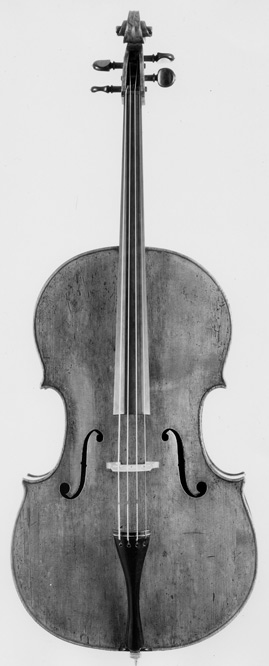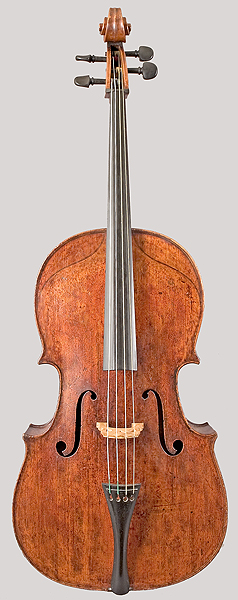Antonio Stradivari
and the Cremonese Viola da gamba
One of the greatest violin makers of all time, the Cremonese Antonio Stradivari made at least six different models of bass violas da gamba, with five, six or seven strings. These instruments were all subsequently transformed into violoncelli and are now being played as such on every stage in the world. He also made at least three different models of treble violas da gamba, with figure-eight design or with violin-corners. Some have indeed been converted into violins! Many of the forms and matrixes he used for the making of viols are today in display at the Stradivarius Museum in Cremona.

Bass viola da gamba by Antonio Stradivari
now converted into a violoncello.
(Photo courtesy of Charles Beare, London)
This rare example of a viola da gamba by Stradivarius was subsequently converted into a violoncello. The original flat back is conserved with the instrument, but the present violoncello has a recently made shaped back. The body has been reduced in its dimensions, both at the top and at the bottom. The head is also of recent date; the original would have had six or even seven strings. (information: Charles Beare). Some documentation about the apparently quite routine conversions of viols into violoncelli and violins during the 19th and 20th Centuries is found in the works on Stradivari by Hill's and Sons. There the converted viols are even specifically identified by their proper names.
Here another viola da gamba, converted to a violoncello:
Bass viola da gamba by Antonio Stradivari, later converted to a violoncello.
The original outline of the viols is visible in the region of the shoulders. Although he
also made viols with rounded backs, this viola da gamba had originally a flat back.
(Photos: The Shrine to Music, South Dakota)
Bass viola da gamba by Antonio Guidantus, Bologna, 18th C.
(Photos: The Shrine to Music, South Dakota)

Bass viola da gamba, Cremona, ca. 1700 (lost likely: Pietro Guarneri of Mantova)

Bass viola da gamba by Giovanni Battista Grancino (Milano, 1697)
This beautiful example of an Italian viol of around 1700 has been set up according to the measurements of Stradivari. The neck, the fingerboard and tailpiece were copied from his patterns and matrixes in the Cremona Museum, including the shield which would have contained the coat of arms of the owner's family. The scroll, on the other hand, has been copied after existing Grancino originals.
Über die Violen da gamba von Stradivarius
“Das älteste uns bekannte Sradivari-Instrument der Cello-Familie stammt aus dem Jahre 1667, als der Meister 23 Jahre alt war. Obwohl es wesentlich verändert wurde, ist es ein sehr interessantes Instrument. Man kann erkennen, daß Stradivari die Hauptmerkmale von Gambe und Cello zu vereinen suchte, nämlich einerseits den flachen Boden mit dem abgekanteten Oberteil, andererseits die Form, F-Löcher und Maße der Cello-Familie. Wir vermuten, daß dieses Instrument wie eine Gambe besaitet war, allerdings ist der originale Kopf verloren, so kann man es nicht mit absoluter Sicherheit bestimmen.
Es ist auch eine Viola da Gamba bekannt, genauer gesagt, ein Instrument, das urprünglich eine Gambe war. Das Instrument wurde vergrößert, und es wurde sogar ein Wappen aufgemalt, um die Nahtstellen mit dem angesetzten Holz zu vertuschen. Es kann sich möglicherweise um die Viola da gamba handeln, die von Stradivari 1684 für die Contessina Cristina Visconti gebaut wurde. Die Schablonen befinden sich in der Dalla Valle-Sammlung.
Ebenfalls von 1684 stammt ein Cello, das dem Cellisten Leo Stern gehörte. Seine Maße sind noch immer extrem groß, und ein fünftes Loch im Wirbelkasten weist klar darauf hin, daß es sich urprünglich um ein fünfsaitiges Instrument handelte. Obwohl es in jeder Hinsicht wie ein Cello gebaut ist, war es eindeutig als Baßgambe mit sehr großer Mensur geplant.”
(Aus: W.H. Hill, "Antonio Stradivari, his life and work" 1902)
In der Werkstatt von Stradivarius befinden sich die Schablonen und Formen für nicht weniger als fünf verschiedene Modelle, darunter auch eine “viola alla francesa a sette corde”, wonach diese Instrumente hergestellt worden sind. Heute sind sie als Violoncelli in den Händen internationaler Solisten zu bewundern. Nur wenige sind heutzutage in der ursprünglichen Form als Violen da gamba erhalten.Stradivarius baute offensichtlich die folgenden Modelle:
- Eine sehr große, fünfsaitige Viola da gamba mit Ecken, flachem, abgeknicktem oder gewölbten Boden
- Eine siebensaitige, französische Viola da gamba nach der Form B für Violoncello. Das Aussehen kaum von einem Violoncello zu unterscheiden; lediglich die Anzahl der Saiten (natürlich auch Halsbreite, Kopflänge für die sieben Wirbel!)
- Eine sechsaitige Viola da gamba mit entweder flachem oder gewölbten Boden
- Sechssaitige Diskant Violen da gamba mit Ecken, gewölbtem oder flachem Boden.
- Sechssaitige Diskant Violen da gamba ohne Ecken “Keines dieser Instrumente befindet sich jetzt noch im originalen Zustand, weil sie alle zu Violinen umgebaut worden sind”. (Sacconi)
-
updated18.06.2011


